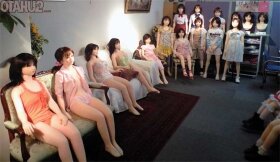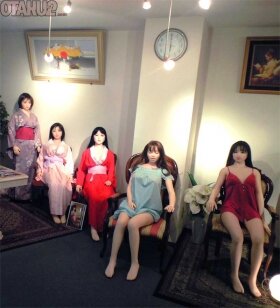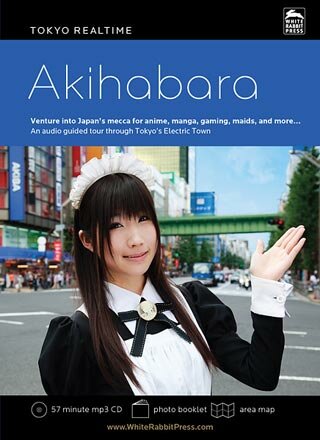 Filed under: Dolls Candy Girls Orient Industry Volks
Filed under: Dolls Candy Girls Orient Industry VolksJapanese Doll Boom
20.06.2008 by Patrick W. Galbraith
At Kiyomizu Kannondo temple in Ueno, a funeral is underway. A dozen or more monks kneel chanting Buddhist sutras, their voices building into a roaring crescendo as they move to put another soul to rest. But the “soul” they tend to this day is that of a doll—specifically, a well-used “love doll” being returned to its maker after the owner got married. The ceremony is called ningyo kuyo, or a doll funeral, and commemorates sending the unit to the factory for dismantling.
“She was glowing with love from her owner,” says Nakamura Yoshio, 63, one of several employees of doll manufacturer Orient Industry who attended the event. “Now she will return to her factory home, like satogaeri—the ex-wife going back to her family.”
Nakamura’s intense affection is characteristic of doll lovers in Japan (often called “dollars” but preferring the term “doll users”), whose ranks are at least 20,000 strong and growing. Even as sex dolls draw criticism and disappear from Tokyo’s backstreets, benign sellers running the gamut from collectible to huggable, from love dolls to porcelain pieces, are doing brisk business as the image of dolls and their users steadily improves with positive media exposure.
Japan has used dolls for religious and ceremonial purposes since around 1,000 A.D., and in the Edo Period, the country was quick to pick up on such Western innovations as karakuri ningyo robots and “Dutch wives.” According to Takatsuki Yasushi’s From Dutch Wives to Love Dolls, a rudimentary azumagata ningyo appeared in Ryugoku’s Yotsumeya in 1626 and fast became part of the establishment. By the ’50s, the government began using sex dolls to enhance the lives of its workers in remote outposts such as the South Pole. A string of movies in the ’60s and manga in the ’70s, including Matsumoto Reiji’s Sex Droid, Ishinomori Shotaro’s Sexadoll and Tezuka Osamu’s Yakeppachi no Maria, cemented dolls in the popular consciousness.
It was at this time that Orient Industry burst onto the scene with the manifest of turning dream dolls into a physical reality. Its 33 employees make just one product, dolls, and manage the process from the beginning of the production chain at their Katsushika factory to the final sales and customization in Tokyo and Osaka outlets.
Their Candy Girl series, supple silicon flesh over flexible metal skeletons, is legendary in Japan, so much so that Vanilla art gallery hosted Orient’s 30th anniversary exhibition in Ginza in June 2007.
“That event was something of a coming out for us,” says Nakamura, the Ueno showroom manager. “We aren’t targeting otaku or people with a doll fetish. That boom has come and gone. Now we are getting a lot of healthy, normal people.”
It is Orient’s policy never to reveal its sales figures, but sources say that the company sells at least 50 dolls priced between $1,300 and $6,900 each month, shipping them to destinations in Asia, Europe and the US.
A conservative estimate, then, is that Orient makes over $200,000 a month on dolls alone, and when parts, accessories and service are factored in, this total jumps drastically.
Indeed, at Orient’s showroom in Ueno, staff conduct 130 tours per month for groups of 1-10 people. Entry is on a reservation basis and limited to 30 minutes per group.
Many don’t even make it past the door.
“Some people get the mistaken impression that this is a toy store or rental space, but we turn these people away,” Nakamura says. “We are near Akihabara here, so young people come down en masse looking for fun.”

Orient’s newest and most expensive line, Diva, is sculpted to be anatomically correct in every way—similar to the US-made Real Doll—but the Petite series of child- or anime- like characters is the more popular choice.
That’s the case at a doll rental space in Shinjuku, established in 2005 when there were some 150 such shops in Japan—but now the last of its kind in Tokyo.
“I run a burasera [used uniform] shop, so I know well what the customers want,” says “Ace-san,” 54, who asked that neither his nor his store’s name be revealed. “I partnered up with doll producers to provide them with proper uniforms, not just cheap costumes, and still have these connections. I am also a friend of the man importing Real Dolls, so I can get a better price.”
That’s one reason he manages to hang on as one of the last 20 doll rental establishments in all of Japan.
The reasons for the industy's decline are many, including the negative image attached to sex dolls, the inability to control how customers use or abuse them, and the high cost of maintenance and replacement. Ace-san has bought four Real Dolls and two Candy Girls in three years, or about $85,000 worth of merchandise, but has only 50 regular customers. The rent for the room housing each doll, a hidden alcove inside a high-rise apartment complex, is $1,000 a month.
There is no business incentive left to cater to doll users, Ace-san says. He nonetheless continues because he is convinced he is providing a service for people in need.
“I went to the Ward Office and told them I could help people who are handicapped or elderly and need these dolls,” he says. “Of course, the government cannot officially support the sex industry, but five of our customers come together with caregivers saying the Ward Office referred them. People may not like it, but this is a necessary thing so that some people can function.”

It’s debatable to what extent geriatric or disabled clients can manipulate the dolls, which weigh in at around 60kg, but these two demographic groups have traditionally been the top customers. According to Orient, the most popular reasons for buying or renting dolls are physical ailment, advanced age, loneliness, fear of STDs and “being afraid of women, scandals or rejection.”
“Whatever else might be said, it is safe,” says one Orient customer, “Tanaka,” a member of the Doll Photography Society, whose members dress Orient products and pose them as models in exotic locales. “You know what you are getting, you know the possibilities and the limitations.”
Nakamura estimates this is precisely the kind of relationship customers want.
“A doll is soothing, iyashi, which is exactly what stressed people need,” he says, pointing out that huggable body pillows emblazoned with anime characters sell out across Tokyo despite a $150 price tag. “Owners long for companionship.”
On the other end of doll user spectrum—the nonsexual end—feelings of purity and iyashi are among the top appeals for fans of Volks’ highly sought after Dollfie series.
“It’s very soothing for me to have my dolls watching over me in my room,” says Koji, a 27-year-old Dollfie enthusiast. “It used to be that men couldn’t even have dolls, let alone play with them. But with these, you can pose them, change their heads and clothes, you can make them as you want to. It seems natural for figure collectors to go to the next stage of more customization and posing.”
And fans pay for that upgrade—a standard Dollfie, before accessories or customization, costs between $500 and $1,000.
Resin-cast Dollfies were created in 1998 in response to the burgeoning domestic interest in expensive French imported dolls. Their manufacturer, Volks, was famous for its figurines and model business, and Dollfies' combination of high quality and low price started a boom. The scene further exploded with the popularity of anime like the Ghost in the Shell TV series (2002) and Rosen Maiden (2004), the story of a boy who becomes slave to a doll. Another factor was the inclusion of ball joints, which make it possible to pose the dolls for pictures, a favorite pastime among users.
Volks now has around 30 shops worldwide and boasts $50 million in annual sales—but is careful not to let the publicity turn sour and is distancing itself from comparison to sex dolls or association with otaku.
“When the dolls started to go into limited editions, that is when the maniacs started to get interested,” says a Volks representative at the company's Akihabara showroom. “However, our products were not intended to be for otaku and are not limited to Akihabara.”
For their part, Dollfie fans also want to distance themselves from negative stereotypes, and seldom publicly display dolls. They further make a distinction between the majority of “dry users,” or collectors interested in how their dolls look, and the minority “wet users,” or those who make an emotional investment in their dolls, sometimes even publicly carrying, caressing and talking with them.
“The media thinks that we do this because we are perverts with sexual feelings for our dolls or something,” says “Dragon,” a dry user who owns some 20 limited edition Dollfies. “I like dolls because of their artistry and beauty. They are not cute like anime characters, but sophisticated and beautiful.”
Like Orient’s dolls? No way. To Dragon, they are to Dollfies what tigers are to cats.
Dragon is friends with many other users, but prefers to keep his avocation a secret and so only meets them at St. Grace’s Court, a doll user-friendly costume café outside Akihabara, and dolpas, or doll parties where fans can get together.
The last one, Dolls Party 19, was held April 27 at Tokyo Big Sight and drew 15,000 fans to buy, sell and trade limited edition, fan favorite or even fan-produced dolls. For the first time, men comprised 30 percent of all attendees. The events held in Kyoto, the hometown of Volks, are far larger and more diverse.
A popular subsection of Dolls Party 19 was miniatures, such as Petite Ai and Volks’ own YoSD and Yo Tenshi, limited edition series fans can acquire only on Yahoo! Auctions or at doll parties. These little guys and gals are especially popular for carrying around and posing for photo shoots.
While Orient says users treat their dolls as wives, these miniatures are more often treated like family or children. Yo-sizes have very little body definition, and their slightly thicker stature make them incredibly child or baby like. Many owners carrying Yos have them in turn carrying small toys and coo softly to them.
There are even smaller sizes—referred to as “tinys”—which mostly just sit pretty with their owners. Though a lot of owners treat tinys in a similar way to Yos, their unreal smallness imbues them with a sort of ethereal-like “pixie” or “fairy” quality that lends itself well to unorthodox posing.
Those who are more interested in the “wet” side of fandom attend doll koryukai, or “exchange parties,” to talk and play with dolls among invited guests. Who is on the list and where the events occur are carefully guarded secrets shared only by members by cellphone.
Wet users are overall a shy bunch, but one young lady agreed to explain her activities.
“People can’t hear my friends [dolls] because they don’t believe,” says Mai, a 23-year-old college student from Hiroshima who has been talking to dolls since she was a child. “You can’t approach them like objects.”
Unlike dry users, Mai and her friends would never dream of selling their dolls.
Dragon—a dry user who nevertheless has become hesitant to sell his merchandise and who has started attending doll exchange parties—thinks it may be time for him to take a reality check.
“If I continue on this path I might go wet,” he said.
Is Japan on the same path? At least one man thinks so.
“Buying a doll is like yomeiri, it’s a serious investment like a marriage,” says Nakamura of Orient Industry. “Many Japanese have stopped getting married, so maybe this is what they need in their lives.”
Hello Dolly!
Get a taste of doll culture in Tokyo
Orient Industry
The first and largest showroom for Orient is located a stone’s throw away from Akihabara (left). Reservations are required for a 30-minute visit, but inside are dozens of models and lines, including some 15 variant faces. The atmosphere is decidedly disquieting, but under the gaze of hundreds of dolls one can test the weight, durability and flexibility of Orient products before buying.
Suguru Building, 2F, 5-23-11 Ueno, Taito-ku. Tel: . Open daily 11am-6pm. Nearest stn: Okachimachi.
http://www.orient-doll.com/top.html
Volks Akihabara Showroom
This shop on the sixth floor of the Radio Kaikan is the crowning jewel of the Volks doll empire—more a museum than a store. Walk the aisles and see completed Dollfies, consult experts and thumb through albums of photos taken by customers. The showroom also offers the latest information on dolls parties.
Radio Kaikan, 6F, 1-15-16 Soto-kanda, Chiyoda-ku. Tel: . Open daily 11am-6pm. Nearest stn: Akihabara.
http://tinyurl.com/6oh6vs
St. Grace’s Court
This unique costume diner is a “sister café” where nuns alternate between serving tea and engaging in mock Catholic ritual. The staff and customers are all hardcore fan types, and the owner allows them to organize exchange parties (koryukai) and take pictures of their dolls. There is even a “doll set” (¥700) of miniature tea and sweets on the menu for users to order for use in posing their dolls or offering them refreshments.
Chiyoda K1 Building, 1-B1F, 2-19-33 Kanda Sudacho, Chiyoda-ku. Tel: . Open Mon-Thu noon-11pm, Fri-Sun noon-5am. Nearest stn: Akihabara.
Café Saya
A hotbed of doll user activity located outside Shinjuku, Saya is an antiquated café boasting an impressive lineup of doll events, including private exhibitions and sales, do-it-yourself workshops, and doll exchange parties. Like many such places, the space is typically only open when rented out for events, and these can be reservation-only or private affairs. Saya does, however, run a doll café most Saturdays.
3-37-1 Kamiya, Kita-ku. Tel: . Open noon-6pm (different if there is an event). Nearest stn: Higashi-Jujo.
http://cafesaya.net/CAFE/
Maiden Doll and Dollfie Dream Gallery
These websites, made by users to display pictures of dolls, are among the hundreds in cyberspace. Fans submit reviews, share thoughts or send in their own images. Though most of the text is in Japanese, the beauty of the dolls and depth of activity on the part of users comes through.
http://dollfiedream.arcadiangarden.com/
Dolls Party
For more information on Volks’ Dolls Party events see
www.volks.co.jp/jp/event/dolpa_portal/index.html
Comment on this article

- Maiden Doll
- Dolls Party
- Dollfie Dream Gallery
- Orient Doll
- Volks Akihabara Showroom
- Cafe Saya
- Site of someone married to a doll

14.07.2009 · Blog
Dolls on display at posh Harajuku opening
I was invited to the opening of Glaceau Gallery an art space in Harajuku. It is on the 9th floor of the H&M Building, and considered very...
11.07.2009 · Blog
Busy week ANN and a vist to Danny Choo's office WooHoo!!!
This week was my four year anniversary living in Tokyo. I moved here on Saturday July 8th 2005 the opening day of Star Wars Revenge of the...
22.02.2009 · Features
Macross 2009.2.22 Launch Event Wrap-up
The Macross SDF-1 launching ceremony based on fictional events which played out during the first and second episodes of the original...
09.01.2009 · Resources
Volks Shop Finder
The following link leads to a Google Map detailing all of the Volks Showroom and Tenshi no Sumika locations in Japan. In addition to...
26.11.2008 · Features
Miyazawa Mokei Show Fall 2008
Miyazawa Mokei Show was on November 19th, 2008 and held in a new location next to Kinshicho station inside MARUI's 8th floor exhibit space....
02.11.2008 · Reviews
Doll Review - Yamato's vmf50 Lynn Minmei
Super-dimentional Obitsu remembers love...


























4 CommentsComment Page 1 of 1
Patrick wrote on 09.11.2010:
@golden hero Here is the order page for Orient Industry, which should have all the info you need: http://order.orient-doll.com/action/shop. This is Japanese only, I am afraid. You can make inquires about an overseas purchase here: http://www.orient-doll.com/contact/. Again, please be aware that this is Japanese only. If you write to them in another language, they might take a long time to respond, if they do at all. Good luck!
golden hero wrote on 09.11.2010:
could you please tell me prices of dolls,sizes and whom which I can contact.For me I really love rubber's dolls instead of ladies.
Please tell me
Dollcumentary wrote on 27.12.2009:
I have to second what dollsdollsdolls has to say. There is a HUGE difference between those who are doll fanciers and those who are "into" sex toys.
Most of the people who are doll fanciers and who have one or more high-end resin Asian Ball Joint Doll are as far from the "drooling ecchi fanboy" stereotype as you can get. Here in the US we are predominantly female, and we are into the aesthetics of the dolls. Dolls as art. Most of us actually create things for our dolls, and some of us even do our own faceups on the dolls to make them unique and one-of-a-kind.
There seems to be a growing number of male doll fanciers in Japan, a crossover from Figure Otaku-dom. They have latched primarily onto the Volks Dollfie Dream line of vinyl armature dolls. They are less expensive than Volks' high-end Super Dollfie line of resin ball joint dolls, and are often based on Anime character designs. The Dollfie Dream Dynamite line in particular is beloved by these guys because...well...they are quite "up front" if you know what I mean.
I myself own a Volks Dollfie Dream. I guess you can say I'm "pwned by" my Dollfie Dream considering everything. It was initially a purchase of a very good friend of mine who bought her on a whim. I wound up a bit more interested in her than he was, so she eventually wound up with me. She's actually one of their original character dolls, a Yukino.
She's got a companion now, from the doll company Obitsu, which has been altered and customized and faced up to look like a "bishounen" or pretty boy guy. Yumiko (the Dollfie Dream Yukino) and Zetto (the Obitsu boy) are joined in my collection by a host of 1/6 scale dolls, some more appropriately "Action Figures," others considered Asian Fashion Dolls.
I even have a fair amount of those dolls from over here in the States -- cough Barbie cough -- and their most recent "Fashionista" line which takes the traditional Barbie and adds jointing that favorably compares to some of the Japanese 1/6 scale dolls shows that even Mattel is paying attention.
Maybe this should have been two articles, to be fair: one about love dolls, the other about the doll fancy.
dollsdollsdolls wrote on 18.10.2008:
that is so gross! how can you mix up stuff like abdjs and love dolls? i want to say that i respect both forms of content, but there should be a limit to how close you can weave the two subgroups together.
to draw a comparison, what if you bunched in erotic computer game players with all gamers? or, hentai enthusiasts with all anime fans? porn and cinema? dedicating so much of the article to a sexually oriented topic, you're creating a false impression of abjds, which (for no apparent reason) come at the end of this otherwise fine piece on love dolls.
from what it seems, i'd imagine this type of comparison makes it even more difficult for abjd owners. if they already feel like stigmatized outcasts... wouldn't this just bring even more resentment towards them?